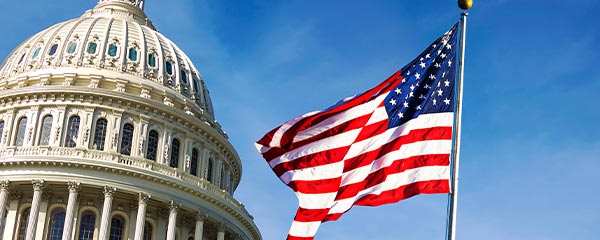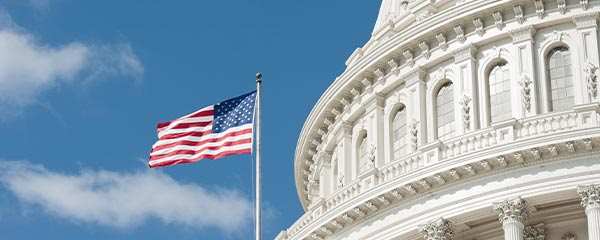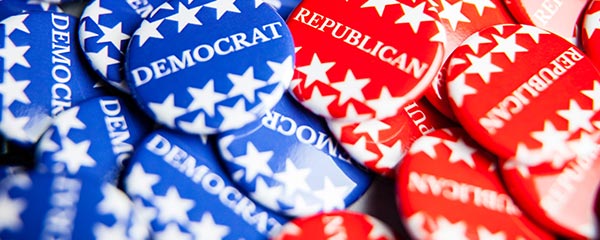Story Highlights
- 41% of Americans favor unified control of federal government
- 23% want divided control
- 52% of Republicans, 43% of Democrats favor one-party control
WASHINGTON, D.C. -- A new high of 41% of U.S. adults say it is better to have a president and Congress from the same political party. Twenty-three percent would rather have one party control the presidency and the other control Congress, while 32% say it makes no difference to them.

Line graph. A record 41% of U.S. adults in 2020 say it is better to have a president who comes from the same party that controls Congress. The 23% in 2020 who favor having a president from one party and Congress controlled by another is near the record-low 20% from 2016.
The results are based on Gallup's annual Governance survey, conducted Aug. 31-Sept. 13, and come at a time when Americans are deciding whether to elect President Donald Trump to a second term in office. Republicans also control the Senate with a 53-47 majority -- which is at risk, given that more Republican-held seats than Democratic-held seats are thought to be vulnerable in the election. The Democrats have a large majority in the House that congressional election experts do not currently believe is threatened.
The prior high in preferences for one-party government occurred in 2012, when incumbent President Barack Obama was running for a second term. One year later, in the midst of a federal government shutdown tied to a dispute over funding the Affordable Care Act, a record-low 25% favored one-party government, with 38% saying it made no difference which parties held the White House and Congress.
Historically, a plurality of Americans have usually said party control of government makes no difference. In addition to 2012 and this year, the other exceptions were 2002 and 2018, both midterm election years, and 2005.
Over the past five years, an average 36% of U.S. adults have expressed a preference for unified party government and 24% for divided government -- a 12-percentage-point difference. Before that, from 2002 through 2014, the gap was just three points, with 31% favoring unified government and 28% divided government.
Majority of Republicans Prefer One-Party Control
Currently, 52% of Republicans, as well as 43% of Democrats, believe it is better to have one party control the presidency and Congress. Just 31% of independents agree, with nearly as many, 27%, preferring divided control of government.
| Republicans | Independents | Democrats | |||||||||||||||||||||||||||||||||||||||||||||||||||||||||||||||||||||||||||||||||||||||||||||||||
|---|---|---|---|---|---|---|---|---|---|---|---|---|---|---|---|---|---|---|---|---|---|---|---|---|---|---|---|---|---|---|---|---|---|---|---|---|---|---|---|---|---|---|---|---|---|---|---|---|---|---|---|---|---|---|---|---|---|---|---|---|---|---|---|---|---|---|---|---|---|---|---|---|---|---|---|---|---|---|---|---|---|---|---|---|---|---|---|---|---|---|---|---|---|---|---|---|---|---|---|
| % | % | % | |||||||||||||||||||||||||||||||||||||||||||||||||||||||||||||||||||||||||||||||||||||||||||||||||
| Same party | 52 | 31 | 43 | ||||||||||||||||||||||||||||||||||||||||||||||||||||||||||||||||||||||||||||||||||||||||||||||||
| Different parties | 17 | 27 | 23 | ||||||||||||||||||||||||||||||||||||||||||||||||||||||||||||||||||||||||||||||||||||||||||||||||
| No difference | 27 | 36 | 30 | ||||||||||||||||||||||||||||||||||||||||||||||||||||||||||||||||||||||||||||||||||||||||||||||||
| Gallup, Aug. 31-Sept. 13, 2020 | |||||||||||||||||||||||||||||||||||||||||||||||||||||||||||||||||||||||||||||||||||||||||||||||||||
Republicans' current preference for one-party government has been exceeded only once, in 2018, when the party controlled the presidency and both houses of Congress. Historically, partisans' preferences have been shaped by whatever arrangement benefited their party most. As such, when Republican Presidents George W. Bush (2001-2008) and Trump (2017-2020) have been in office, Republican Party supporters were more likely than Democratic Party supporters to favor one-party government. When Democrat Barack Obama was in the White House, Democrats were generally more likely to favor one-party control of the federal government.
In nearly every year, independents have been less likely than both Republicans and Democrats to want the same party to control the White House and Congress. And while the typical pattern holds this year, the 32% of independents wanting one-party control is the highest measured for that group to date. The 43% of Democrats favoring one-party control this year exceeds what it was in several of the Obama years.

Line graph. Republicans' current 52% support for one-party government is down slightly from 59% in 2018 but one of their highest percentages to date. Democrats' support for one-party government is the highest it has been in a year when a Republican president was in office.
Implications
The consequences of divided versus one-party control of government are clear right now as Trump and the Republican-controlled Senate attempt to fill the open Supreme Court seat -- created by Justice Ruth Bader Ginsburg's passing -- before the Nov. 3 federal elections. When Obama nominated Judge Merrick Garland in 2016 after Justice Antonin Scalia's death, the Republican-controlled Senate refused to consider the nomination. Given that the Democratic-controlled House of Representatives has no formal role in judicial confirmations, and a simple majority in the Senate is needed for confirmation, Trump nominee Amy Coney Barrett seems likely to be confirmed.
Americans' preferences for one-party or divided government appear to be rooted in the desire to maximize their party's power more than philosophical considerations about what leads to better political outcomes. The poll was conducted before Ginsburg's death, so it is unclear whether Americans are any more, or less, likely to favor one-party or divided government today. The results of the November elections will shed light on whether Americans want to retain some form of divided government or give one party full control of the federal government.
View complete question responses and trends (PDF download).
Learn more about how the Gallup Poll Social Series works.




